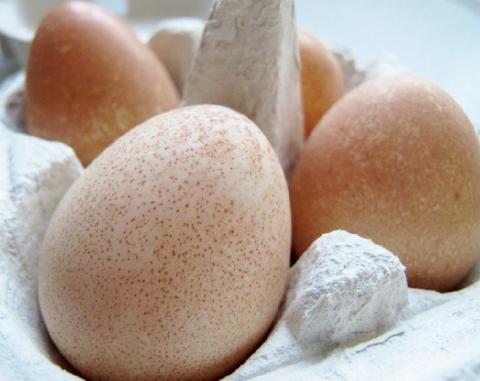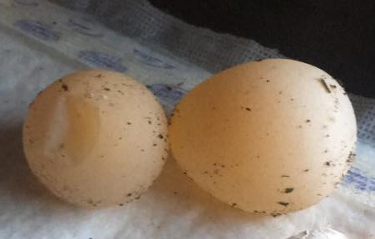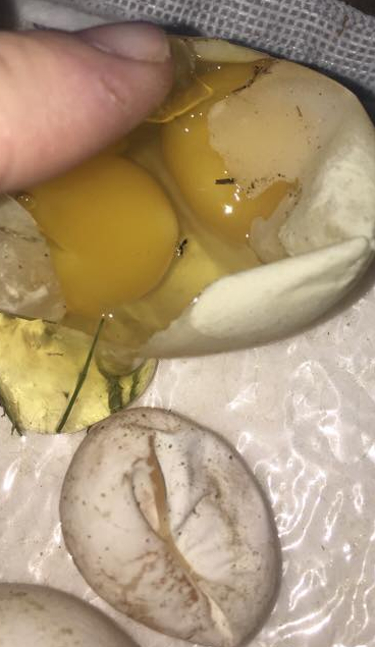Guinea fowl hatching eggs and how to select them.

Guineas normally lay a very consistent egg on a daily basis in spring and summer. The eggs have very thick shells which does make it a little easier as cracked eggs is much less of a problem. Choosing the right eggs to incubate is critical to getting a good hatch rate.
The best Guinea fowl eggs to choose for hatching are average sized and well shaped without any cracks, odd shapes or porous shells. Egg selected for hatching should be candled beforehand to check the air cell is in the correct place and the membranes are intact.
Below: A good example of Guinea fowl eggs.

If you're not choosing from your own hatching eggs, make sure you buy from a reliable source. Ideally you would want to see the eggs and choose them for yourself. Places like eBay or Craigslist are not always the best as sellers could be sending anything. A local independent breeder is ideal.
Active free range Guineas with their males (cockerels) in a healthy environment and fed a good diet will lay strong, clean, well-formed eggs which will have the best chance of hatching. Choosing the correct hatching eggs will give you a better hatch rate and give your chicks the best start in life.
Choosing the best eggs for incubation:
If you have collected lots of eggs, you will need to select the best eggs to incubate. A good hatch rate is somewhere between 55 and 75% and half of these will be cockerels. A good guideline for selecting eggs is as follows:
The age of the eggs: Fertile Guinea fowl eggs are best incubated when less than 7 to 10 days old. They should be incubated as soon as possible after laying.
How old can an egg be and still successfully hatch? Fertility starts to decline fast after 10 days and hatch rates will suffer.
Egg Size: Choose eggs that are the average in size. If large it might contain a double-yolk, and as much as we all like 2 yolks they should not be incubated. You can use a candler.
Below: Avoid choosing round or soft shelled eggs for hatching:

If the egg is too small it might not have a yolk at all. Average size and shape is the choice. There are quite a few YouTube videos of successful twins hatching from eggs but failure is much more common.
Shell Condition: Look and feel the shell. Eggs can have tiny hairline cracks and unless there is no alternative, these should not be incubated.
If you really want to incubate an egg with a thin crack, some breeders recommend repairing the crack using either sellotape or nail varnish. Just over the crack itself.
Below: Avoid double yolkers, cracked and odd shapes.

Candling will show a saddle-shape at the blunt end. Pick those eggs with a normal shape. Avoid eggs that are misshapen, too long, round or pitted.
You should also check that the egg doesn’t have any other shell abnormalities. Things to look out for and avoid are eggs which are not egg shaped or eggs with ridges, oblong, or overly round. I would also avoid eggs with colour abnormalities like rings or pale splotches.
Storing Guinea fowl hatching eggs:
Before incubation Guinea fowl eggs can be stored for 7 to 10 days.
Store Guinea fowl eggs with the pointed end facing downwards. Make sure the stored eggs are turned daily before they are incubated.
When storing Guinea fowl eggs before incubating, make sure that they are kept at a constant temperature of 6 to 12 Celsius or 40 - 54 Fahrenheit. When storing fertile hatching eggs, keep them cool but not cold and relatively moist.
Packing Guinea fowl hatching eggs for shipping:
Buying by post from a good breeder is more risky but sometimes the only way. Make sure the seller packages them well and labels them 'fragile'. If they're going to be sent to a post office depot, let staff at the depot know you're expecting them and ask them to call as soon as they arrive. Collect as soon as possible.
Guinea eggs might have good solid shells they still need packaging carefully to protect the membranes.
Hatching eggs which have travelled need to be stored safely to rest for at least twelve hours before they're put into the incubator. Take them out of their packaging and store them with the pointed end facing downwards.
Poorly packed eggs sent by post often have a detached air cell caused by jolting en route. These have a practically zero hatch rate and I have never found it worth trying.
Candling Guinea eggs for hatching:
Use a candling lamp or a bright light and assess the feel of the shell.
Discard eggs with cracks no matter how small. Do not try to fix them and they're unlikely to hatch and bacteria in the crack will contaminate the incubator.
Is the egg too porous? I automatically discard any with porous shells. It is a fact that hens that lay porous shells may go on to produce offspring that themselves produce porous shells. You have the ability to choose to select the best and strongest for the next generation.
If the shell is porous, under a candling light it will look mottled. Slight mottling isn't unusual but something that has a speckled appearance under a candling lamp or a chalky feel is unlikely to survive.
If that isn't enough try using dry sandpaper and very gently scraping the shell. The problem with this is the danger of cracking, and the potential for rubbing the bacteria in the dirt into the shell rather than removing it.
Should you clean Guinea hatching eggs or not:
Collect hatching eggs as often as possible and that are as clean as possible. This is difficult with Guinea fowl as disturbed nests are often moved. The problem with putting dirty eggs into the incubator is bacteria, which is potentially fatal for the growing embryos.
There are various options for cleaning, depending on how much dirt there is. If possible, stick with just scraping it off with a fingernail. This leaves the bloom on the outside of the shell, which protects it from bacteria, intact. A nail file or a little sand paper can remove difficult spots.
If it still looks too dirty to put into the incubator, you have the option of gently washing it. Use warm and not cold water and egg washing disinfectant. Some people use a diluted bleach solution but this is not my choice. Gently washing it in warm water will make it clean enough.
I don't like using bleach and have found that warm water generally does the job. It can remove the bloom from the shell, but better that than risking bacteria forming in the incubator.
